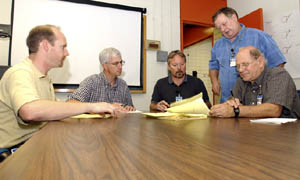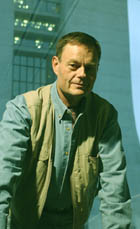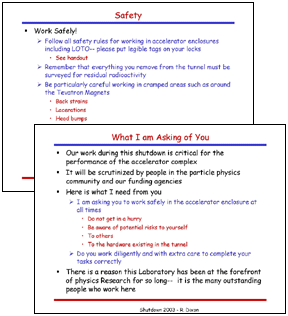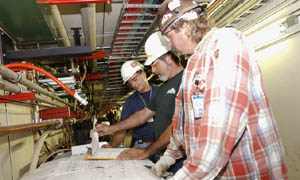 |
|
Only YOU Can Achieve a Safe Shutdown by Mike Perricone One of the most recognizable advertising campaigns ever mounted has spent nearly 60 years pitching safety as an individual responsibility. In 1944, Smokey the Bear began telling us: "Only YOU can prevent forest fires." While the environmental outlook of the message has evolved into a focus on wildfires instead of "forest fires," the key to prevention remains individual responsibility. Smokey's fuzzy-but-somber visage under the Forest Ranger hat continues to remind us that a single person, overlooking a single detail, or having a momentary lapse of attention, can cause a singular disaster. During the lab's 10-week shutdown, that same safety message will bear constant repetition. "No amount of structure or planning can serve as a substitute for people taking personal responsibility for their own safety, and for the safety of those around them," said Fermilab director Michael Witherell. "Much of what we're doing is emphasizing to people that they have the responsibility, and the authority, for creating a safe work environment."
"No," Witherell said simply. "I think it's accepted now by everybody in the laboratory." John Anderson, Senior Safety Officer in the Beams Division, works with those issues of responsibility and authority every day. He concurred with Witherell: the message has hit home. "You might have had to convince people 10 years ago, but not any more," Anderson said. "I think we've instilled safety as a core value here at the lab. Safety is a line function, through the Integrated Safety Management programs, through hazard analyses, all those efforts that go toward pointing out the safe environment we're trying to build for our employees. We want them to regard our department as a resource, not a police department They can come in, ask questions, and we'll help. If they need personal protective equipment, we'll research it, find it, and acquire it for them. People stop in continuously every day of the week." For the message to reach the person on the line with impact, Anderson said it must start at the top and be relayed to each level with the same emphasis: from lab director to division and section heads and on to task leaders and individual workers. It's an especially important relay with people from all over the lab being assigned to shutdown tasks. Bill Griffing, head of the lab's Environment, Safety and Health department, has seen the communication process in action. "When we're in a weekly scheduling meeting with division and section heads, Mike Witherell will stress coordination between groups during the shutdown, and stress the need to communicate early and often," Griffing said. "It helps a lot to have someone like [Particle Physics Division Head] John Cooper tell his people, 'you're working for somebody else now, so make sure you work safely, and if you're told to do anything that makes you uncomfortable, make sure you ask questions and don't just assume it's the safe way to do it.'" Safety officers prepared a handout for tunnel workers stating the goal: "To complete all assigned tasks with no injuries. We will not use an urgent mission as an excuse for shortcutting safety. Help us continue our record of coordinating major accelerator upgrades with no injuries." To encourage communication, and questions, they included a list of contact people and phone numbers in ES&H. They included lists of protective equipment, and reminded workers that all material removed from any beam line must be surveyed for residual radiation. Representatives of ES&H and of the Beams Division's Operations department meet twice weekly to go over work plans and emergency response procedures. Anderson said the same process is followed for a one-day shutdown—"there are just more pages in the worklists on a long shutdown." The lab conducted a three-week shutdown in January 2003 with no injuries, a performance everyone involved would like to repeat.
In fact, Anderson said the plans for the current shutdown began during the last shutdown: identifying tasks, assessing resources and staffing needs, and asking help from other divisions and sections. Task managers, project leaders or crew leaders submitted work lists of all the jobs planned during the shutdown. Anderson pointed to the preparation—of people and process—as the critical factor in January's injury-free shutdown. "Job planning is truly one of the keys to doing work safely," he said. "Task managers will sit down and think about the work to be done. They'll talk with workers, planning how the job is to be done, and working through all the steps. They'll conduct a hazard analysis process to identify all the steps that are going to occur, identify all the safety issues associated with those steps, plan for proper safe conditions and identify the proper equipment for the task. Job planning is truly the key."
"A shutdown of this duration, utilizing such a large force of workers, can mean the accumulation of a significant collective dosage," Gerardi said. "As preparation, I'll review the work lists to determine the controls needed for all the proposed jobs, based on dose rates in the areas where the work is to be completed. Some jobs will require formal ALARA [As Low As Reasonably Achievable] Plans to minimize the absorbed doses of workers performing the tasks." In this shutdown, the Booster collimator installation, the Linac Lambertson magnet replacement, and the exchanging of a four-magnet dipole string were earmarked for ALARA planning and continuous radiation safety coverage. Gerardi went through the list of radiation safety preparations for installing the Booster collimators:
But while the work is going on, Anderson said, somebody usually is looking. "Safety officers typically tour work areas regularly," he said, "wandering through the enclosures looking at activity on a daily basis. Usually, a couple of times a week we'll have outside visitors. For example, representatives from the Department of Energy will go on tours with us, to look at work activities. Occasionally, we'll get a worker coming in who says something just doesn't seem right. When that happens, we'll go out and review things immediately." Yet as Witherell pointed out, no amount of preparation can replace a personal sense of responsibility. "We've tried to let everyone know that we believe we've given everyone all the necessary equipment to do their jobs in the tunnel safely," Anderson said. "But if they think they're missing something, or if they don't understand something, stop and ask. Because if something doesn't sound right, it probably isn't." On the Web:
Beams Division–Environment, Safety and Health Department
Smokey the Bear |
| last modified 10/1/2003 email Fermilab |
FRLsDFx9eyfrPXgV


 If job planning is the key to safety, attention to detail is the key to job planning. As Beams Division Radiation Safety Officer (RSO), Mike Gerardi is responsible for assessing and monitoring the radiological conditions in the division, and for implementing the controls necessary to comply with federal, state, and Fermilab regulations—and the lab regulations are the most stringent. No employee or contractor may receive more than 100 millirem of radiation in any week. Task managers are required to turn in weekly dosimeter reports for members of their work crew.
If job planning is the key to safety, attention to detail is the key to job planning. As Beams Division Radiation Safety Officer (RSO), Mike Gerardi is responsible for assessing and monitoring the radiological conditions in the division, and for implementing the controls necessary to comply with federal, state, and Fermilab regulations—and the lab regulations are the most stringent. No employee or contractor may receive more than 100 millirem of radiation in any week. Task managers are required to turn in weekly dosimeter reports for members of their work crew.
